
Howardena Pindell
“A return of the most violent aspects of primitive accumulation has accompanied every phase of capitalist globalization, including the present one, demonstrating that the continuous expulsion of farmers from the land, war and plunder on a world scale, and the degradation of women are necessary conditions for the existence for capitalism in all times.”
Sylvia Federici
“Man was never certain that he was not dreaming, and never sure that he was not mad: ‘do we not often feel ourselves to be in contradiction with our own better judgement?'”
Michel Foucault
“The introduction of the concept of error into pathology is a fact of great importance as much in terms of the change it reveals in what it brings to bear in man’s attitude toward disease, as in terms of the new status which is supposedly established in the relationship between knowledge and its object.”
Georges Canguilhem
“The Messiah comes not only as the redeemer, he comes as the subduer of the Antichrist.”
Walter Benjamin
I wrote last week, not in this blog, but here:
https://www.counterpunch.org/2018/02/01/unreality/
that there seemed a quality of the unreal about current events, and an equal but slightly different unreality that permeated daily life. But there is another level of what feels like more deeply embedded thought processes that pass under the radar, so to speak, of our individual attention, and certainly are invisible to media and institutional cataloguing. One of the most deeply inscribed models for thought, in the West, is one that has to do with an unexamined notion of normalcy. Georges Canguilhem noted that for diseases of insufficiency the treatment was compensatory — but if the ailment were deemed evil in some way, the treatment is one of revalorization. And I think it worth examining these ideas of normalcy and infraction by going back to that lengthy period deemed the *transition to capitalism*. Nobody has arrived at exact dates for this, and it differs certainly from place to place, but for the purposes here the relevant material is connected to the early 16th century through the mid 17th century (and this is really about Europe, for those dates anyway).
Sylvia Federici focuses much attention on the witch burnings in Northern Europe (primarily) during this period. And it is a vastly understudied topic and one germane to the effects of a transitional period, one that established the first stage of Capitalism. I don’t want to examine the nature of primitive accumulation so much as looking at how social re-organization affected thinking and questions of authority.

Michael Williams
Federici notes Michael Taussig’s book ( The Devil and Commodity Fetishism in South America, 1980) and the idea that devil worship and other superstitious beliefs occurred during periods where one mode of production was being replaced by another. But Taussig wrote an addendum to the book’s later editions. In it he tells of hearing, from Colombian villagers, agricultural workers mostly, of the Devil’s contract:
“And having made his contract with the devil, he earns much
more money but can only spend it on luxuries; on butter, sunglasses,
a fancy shirt, liquor . . . If you buy or rent a farm, the
trees stop bearing. If you buy a pig to fatten up, it gets thin and
dies. Secar was the word they used. To dry, to dry up like a green
tree drying out through lack of water, drying to a crisp in the
relentless sun. And the same word applied to livestock, the pig
getting thinner and thinner, wasting away to skin and bone.
Secar. To dry up. Too much sun.”

Steve McCurry, photography.
And he then adds “… may not it also be the case that the story itself of the pact with the devil has a striking mnemonic function, the mnemonic of the evisceration of memory, or at least of memory geared to “experience in the strict sense of the word”? The worldwide ubiquity of the story of the devil’s pact, let alone the intensity of its drama, would therefore speak incessantly, in repetition heaped on repetition, to the sense of losing, just as it speaks to the lust for gaining. Not losing something. Just losing.” And this in turn reminds him of Walter Benjamin’s thoughts on the erosion of *experience*. The ability to remember is under siege (per Taussig). The atrophying of memory follows the loss of the capacity to experience.
“For nature doesn’t prevail as eternally alive and present in the dialectic. The dialectic inhabits the image and at the end of history cites myth as long gone: nature as pre-history. That is why images . .. really are ‘ante-diluvian fossils.'”
Walter Benjamin
So, two things here, one is the occult and the economic as it played out in the burning of witches (a threat to the capitalist class) and the connections between periods of transition and how the occult ties together commodity fetishism and the gradual withering away of experience. Or, rather, the forces that are set in motion to encourage forgetting — forgetting as a tool of pacification.

Wang Zhongjie
The peasant economies of South America existed well into the 20th century, and some beyond that, actually. Many were agricultural and run by women. The fertility of the soil near the equator allowed for yields that seem unthinkable to Big Agra today. To the GM Monsanto system that Vandana Shiva argues against – and her response to a New Yorker piece is worth reading https://permaculturenews.org/2014/09/02/seeds-truth-vandana-shiva-responds-new-yorker/
The Devil’s Contract is a story Taussig heard again and again.
“But the usual story was of a person distant and anonymous, a shadow on the horizon of human possibility, a profiled caricature of a man engaged by destiny—the man like a zombie uttering strange, repetitive cries as he cut his swathe through the forest of cane, the man with the figurine prepared by a sorcerer, the man instantly fired by the plantation overseer because he was cutting so much more than everyone else, the man teased by his coworkers, “My! What a long way you’ve come today with your figurine!” Most everyone had some such story to tell.”
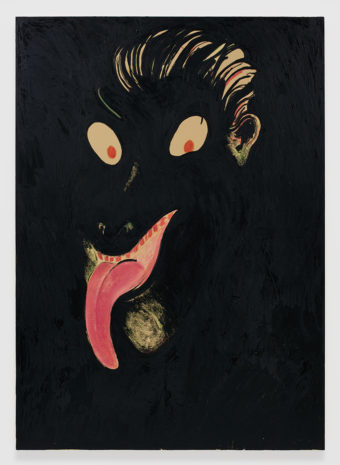
Calvin Marcus
And since, ostensively, I write about aesthetics, I think it worthwhile to reflect on the images here. When one contemplates Hollywood mass produced product (featuring a great many Zombies and no small number of witches and occult demonic forces…in fact demons appear in stunning numbers today) the superficiality of the film zombies and the supernatural is part of their enervating affect. For when Benjamin noted the importance of festival days he was pointing out the recapturing of something not quite totally forgotten. Some glimpse of pre-history. The Baudelarian ‘correspondence’ (mentioned by Taussig). And it strikes me that one of the most pernicious aspects of today’s mass culture, the one disproportionately responsible for what I am calling unreality, is erasure of ‘correspondences’ — the loss of the traditional sympathetic magic of oral traditions and of genuine storytelling.
This is not unrelated, too, to Adorno’s thoughts on the figure of the exile. The stranger in the landscape. But one requires an actual landscape to be able to notice the unfamiliar figure that is, perhaps, only passing through. The elimination of strangeness itself is one of the mandates of mass culture today. It is the assault of the over-familiar. That which is pre-vetted for easy *indentification*. Or as they say in Hollywood, ‘what is the rooting interest’? And Taussig discusses something else. That in these tales told by oral storytellers there was a marked sense of danger. And in a sense the modern correspondence to this is found in Pinter. The danger was of thresholds transgressed, of unexplored regions of experience, or maybe the unexplorable — and more, the danger of speaking of such things outside of ceremonial or ritual space. This is of course where taboos are born.

Jannis Kounellis
And in such a context the revelations of Luther, the filthy lucre that is gold, the ominous black viscosity of oil — often called black gold, loom and resonate.
“Swift’s greatness lies in the intensity, the almost insane violence of that ‘hatred of the bowels’ which is the essence of his misanthropy and which underlies the whole of his work.”
Aldous Huxley
It was Swift who first, in Western literature, recognized the connection between anality and violence, between hoarding and sadism. And hoarding means Gold. (when Yahoo chose its name, did they see the Swiftian irony?).

Ulisse Aldrovandi, 17th century.
“According to Freudian theory the human infant passes through a stagethe anal stageas a result of which the libido, the life energy of the body, gets concentrated in the anal zone. This infantile stage of anal erotism takes the essential form of attaching symbolic meaning to the anal product. As a result of these symbolic equations the anal product acquires for the child the significance of being his own child or creation, which he may use either to obtain narcissistic pleasure in play, or to obtain love from another (feces as gift),or to assert independence from another (feces as property), or to commit aggression against another (feces as weapon). Thus some of the most important categories of social behavior (play, gift, property, weapon) originate in the anal stage of infantile sexuality andwhat is more important never lose their connection
with it. “
Norman O. Brown
That so much shaministic religious practice revolves around excrement seems unsurprising if one thinks about it for a moment. The burning of witches, then, is also a part of the rise of the commodity form. If the first section of Marx’s Capital is to be remembered, the clear geometry of use-value and exchange-value, and how the commodity form was the province of plantation systems, of mechanized production and the destruction of those unexploraable and dangerous regions the capitalist patriarch saw as threatening and associated with or embodied in the form of women. Foucault was correct when he emphasized the role that condemnation of idleness played in the policies of the ruling capitalist class from the late 17th century through the 18th.
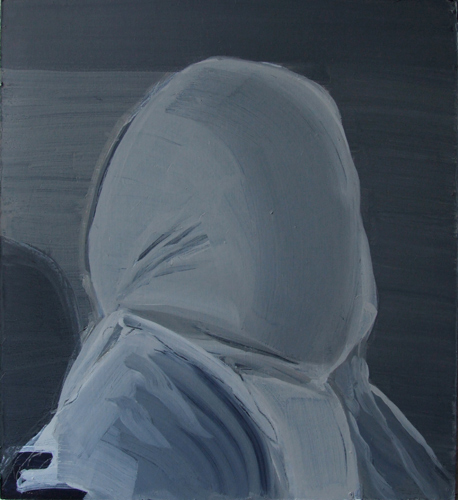
Miho Sato
“Let us return to the first moments of the “Confinement,” and to that royal edict of April 27, 1656, that led to the creation of the Hospital General. From the beginning, the institution set itself the task of preventing “mendicancy and idleness as the source of all disorders.” In fact, this was the last of the great measures that had been taken since the Renaissance to put an end to unemployment or at least to begging.”
Michel Foucault
Federici again,…“At the core of capitalism there is not only the symbiotic relation between waged contractual labor and enslavement but, together with it, the dialectics of accumulation and destruction of labor-power, for which women have paid the highest cost, with their bodies, their work, their lives.”
The reproduction of the same operates on many levels today. And usually in a way that is stripped down and efficient (in theory); it’s is an aesthetics of austerity (a popular word for Capital, for what Federici calls the conquistadors of today, the WBO and International Monetary Fund). For Capital is now forced to denude its own self image in a sense. Austerity is not identical to minimalism — for one is a distillation and the other simply a removal. One of Federici’s most cogent observations is that no witches were burned in the Dark Ages, the central period of medieval Europe. And yet that period was awash in magical belief. But it was a magic that was not confused with daily reality. It was a magic of storytelling and rituals, of the unexplorable. The rise of Capital, and with it science and rationality. The campaign of violence against women was at the behest of a rising Capitalist class that perceived in female autonomy a threat to their new system of domination. They obscured the landscape, and then destroyed it.

Fiona Finnegan
“Witch-hunting reached its peak between 1580 and 1630, in a period, that is, when feudal relations were already giving way to the economic and political institutions typical of mercantile capitalism.”
Sylvia Federici
The campaign of terror against women was not a familiar practice, not was belief in witches something that had flourished in the middle ages. This was a *solution* arrived at by the ruling class. The populace had to be educated to the threat of witches (as they are educated today to fear Russia or Arabs et al). A institutional indoctrination had to be implemented before any ‘panic’ took place. It is worth noting, too (as Federici does and I believe Carlo Ginzburg as well) that witch hunting coincided with the invention of the printing press. And so pamphlets were produced to help alarm the public to the possibility of witches hiding in plain sight within their own communities.
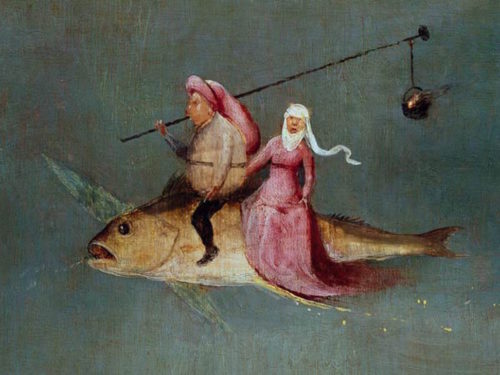
Hieronymous Bosch (The Temptation of St Anthony, 1513. Detail).
The misogyny of the Catholic Church, and the Protestant, too, in a differing way, was well established — and certainly provided the ritual space that would corrupt ideas of magical learning, and of memory itself. It provided the perfect backdrop for with ‘panic’ of witch devilry. It also provided the language and grammer, and the aesthetic. The *solution* signaled, in a sense, the rising power of the capitalist class, just as now the various hysterias of the capitalist class signal its demise. And looking at the overdue recognition of sexual intimidation and harassment of women –especially in the workplace — is re-enacting the witch burnings of the 16th and 17th century. A diluted gesture that retains the contours of the witch hunt. One might stretch this metaphoric model and see in the tsunami of accusations now, driven by celebrity culture, as a displaced form of witch hunting as well; only inverted and linked to the particulars of American puritanism. But the core misogyny is the same from the abusers side, and the same disdain for the working classes, or underclasses, while from the accuser’s side, a kind of mob logic drives the pleasures of now sitting in the chair once held by the Church, (or civil magistrate at the behest of the church…or often, also vise versa). A media spectacle that is an ersatz morality play.
The need is always there in the white male system of power to control and manage the proletariat.
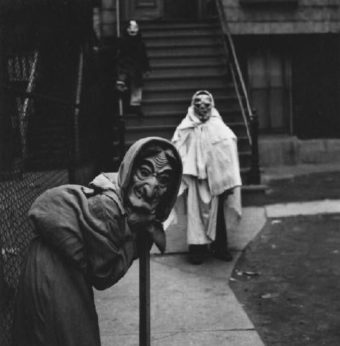
Yasuhiro Ishimoto, photography.
“The political nature o f the witch-hunt is further demonstrated by the fact that both Catholic and Protestant nations, at war against each other in every other respect, joined arms and shared arguments to persecute witches. Thus, it is no exaggeration to claim that the witch-hunt was the first unifying terrain in the politics of the new European nation-states, the first example, after the schism brought about by the Reformation, of a European unification. For, crossing all boundaries, the witch-hunt spread from France and Italy to Germany, Switzerland, England, Scotland, and Sweden.”
Sylvia Federici
The reasons for choosing women as targets during this period are unclear, but it is not difficult to see several at least partially true factors driving this mass violence. One was to reinforce the power of a patriarchal capitalist class in the process of expansion. Women were already feared by the Church, and the punishment and killing of thousands upon thousands made clear that any resistance to the power of this new class would be dealt with harshly. But alongside all this runs the more subterranean psychic terror that was embedded in traditional forms of communality and in traditional knowledge and ritual. An almost instinctual understanding of female reproductive power, the unexplorable mysteries of fecundity and eros was to be attacked. The Shaman and Gold, the anality of Church repressions, the sublimated anger and fear of the patriarchal order was unleashed at the most vulnerable target. It valorized a form of control driven by physical force. But there was also the psychoanalytical aspect of money and its symbolism. In this period of migration and displacement, of the loss of community practices, the role of money struck many in rural Europe (as it did in Taussig’s South American example) as the work of the Devil. The danger inherent in the oral traditions of storytelling, the magical realm of the unseen and the unknown, was being abolished. Today, the panic of the Capitalist class, the ownership class, is from what they see as a surplus population. Only today the function of the commodity form is so internalized that even language has lost its use value, and resistance succumbs, often, to the depleted energy of what previously would coalesce into revolt.
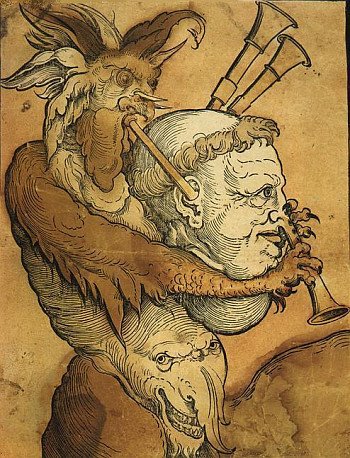
Erhard Schoen. 1530.
The witch burning trajectory began with the rich and aristocracy accusing poor women laborers, rural and in cottage industries, but soon shifted to beggars with accusations coming mostly from neighbours. The focus on idleness again and the idea of sloth replacing avarice as the greatest of all sins. The manufacturing of this panic, though, was clearly something arrived at with a certain consensus between the ruling class, the Church, and institutional officials.
“As for the diabolical crimes of the witches, they to us as nothing more than the class struggle played out at the village level: the evil eye,’ the curse of the beggar to whom an alm has been refused, the default on the payment of rent, the demand for public assistance.”
Sylvia Federici
But here I want to return a moment to Taussig’s Devil’s Contract.
“An old and ubiquitous tale,the devil’s pact seems to be trying to tell us something important about the gift,about the ways it articulates investment versus spending as life-and death issues around the pivot of transgression.”
Michael Taussig

Bárbara Wagner, photography.
For there is a deep truth in the violence of charity, and even of gift giving. It is one of the reasons I’ve always so loathed Christmas. For contemporary society is one of investment. One expects a return. It is only the form of that return that remains problematic and ambivalent. The money in a pact with the Devil is money that cannot reproduce. You must buy luxury goods. You must waste, in a sense. Hoarding is a kind of cover, an alibi. The real transgression lies in knowing there is no return because there is no investment. The charity of the West, of NGOs and white missionary work is saturated with aggression and bad faith. But it is EXACTLY an investment. So, Taussig is using Bataille here, and Bataille is a complicated figure, and one often wrong — but he is wrong in ways that are interesting. It is always the opposite that is true in Bataille — when he is wrong that is. And that is a kind of genius, in a sense. Capital is filthy lucre, it is anality projected outward and it is a contaminent. The Christian gives anonymously, without wanting return. Except of course he does. He always does. The more anonymous the more the desire for return. The Devil bargains. He demands a deal, and you must sign it in blood. Charity is simply aggression masked as virtue. And this is not to say there are not people who do charitable work without contamination. I think they exist. But the general rule of Capital, that system that reproduces its domination and exploitation under all circumstances, encloses and uses the moral compass we assume is not broken. But all moral compasses are broken. That is the rule of moral compasses.
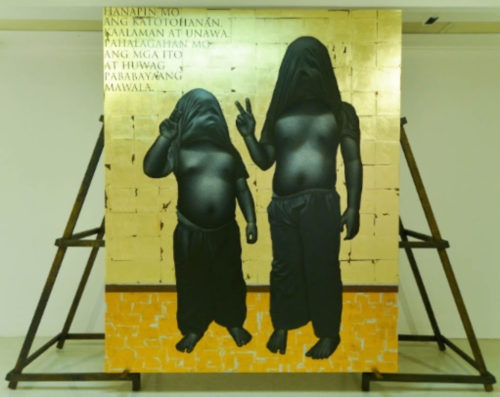
Leslie De Chavez
One thing Bataille correctly noted (and Taussig) is that those cave painting as Lascaux were not religious offerings asking God or Gods for a good hunt. They were an opening to the sacred transgression of killing — or perhaps not even sacred. But the images made the space ceremonial. Therefore the sacred lurks in the shadows. The Shaman and the unknowable and unexplorable. The befouled. It was dangerous to say it aloud, I suspect. Silent prayer has always seemed the only genuine prayer. Taussig writes…” images demanded by the opening to the sacred consequent to the violence of violating the prohibition against killing.This leaves the status of the image, no less than the devil stories,in a strange vacuum of testimony, sanctity, and obligation—not unlike the gift itself, reminiscent of Benjamin’s evocation of the way experience “in the true sense of the word”) was facilitated by collective ritual and festival, amalgamating the voluntary with the involuntary elements of memory. Thus, the stories speak to God, to the world, we might say, not so much to have a social function, satisfy a need, or even betray a cause. They come after the event. As gifts about the gift, they come through me along a long chain of anonymous storytellers to you and function in a sovereign, not a useful, way—to be consumed, in other words, inside themselves as ritual art expended in a storm of negation.”
“In fact, the relation between the practice of confinement and the insistence on work is not defined by economic conditions; far from it. A moral perception sustains and animates it. When the Board of Trade published its report on the poor in which it proposed the means “to render them useful to the public,” it was made quite clear that the origin of poverty was neither scarcity of commodities nor unemployment, but “the weakening of discipline and the relaxation of morals.”
Michel Foucault

Dora Longo Bahia
Prisoners get work furloughs. It remains the indelible truth of Capitalism. During the witch hunts the most common images in the minds of the populace were linked to reproduction. To fertility. Witches tended to be old, past child bearing age. They fed on the vitality of the young. They also were accused of placing curses on men to render them infertile. The obvious symbolism connects to the dynamism of capital. To expansion and conquest. My impotence must be witchcraft!
“The persecution of the witches was a manifestation of the rising modem society and not, as is usually believed, a remnant of the irrational ‘dark’ Middle Ages.”
Maria Mies
But reproduction and fertility have links to labor and economy. Many witches were midwives and with a growing valorizing of medical science the practices learned from traditional community elders were to be excised from the new body politic.

Ad for Plymouth *Barracuda*, 1964.
There was additionally a revising of all those who fell outside of useful labor.
“A familiar figure on the human landscape of the medieval world, the madman had come from another world. Now he stood out on the background, a problem of ‘police,’ a matter of social order for individuals of the polity. Once, he was welcomed because he came from without; now he was excluded because he came from within, and the mad were forced to take their place alongside paupers, beggars and vagabonds. An ambiguous welcome awaited them, in the form of this public health measure that put them out of circulation: the mad still wandered, but no longer on the road of a strange pilgrimage– they just troubled the order of the social space.”
Michel Foucault
The sin of sloth and idleness was extended to anyone unfit for work. The logic of contemporary capital, a system in which there are ever fewer jobs and where being fit for work has lost much of its meaning, there remains many of the same stigmatizing categories. The liberal humanism that looks to treat mental illness today is indeed far more compassionate than in previous centuries, but the economic forces that discipline the underclasses cast a shadow over even these ideas of care and treatment. For fewer and fewer can afford care and the solution now resides in various strategies of containment. From chemical warehousing to the new digital containments of social media and entertainment. The very poor are simply disposable. That ‘other world’ from whence came the madman and stranger has long ago been bulldozed and gentrified. Both literally and metaphorically. And it in this metaphoric paring away of the unfamiliar that has most deeply affected the aesthetics of the contemporary West. The result of Capital’s logic has been to remove the interesting. With it comes the atrophying of curiosity and eventually imagination altogether. The transitional period that led to Capitalism, if one generalizes here, began with wholesale campaigns of violence and terror. Witch burnings were firstly the ruling class removing a perceived threat, and secondly the cleansing of magic and with it community. And that magic and that community has never returned. In one sense this is why the collapse of the Soviet Union was felt in such a deep and unsettling way throughout the world. For whatever the flaws (and I am not sure there were all that many), the symbolic importance of anti capitalism cannot be over emphasized.

George Brassai, photography.
The photo above by Brassai feels as if could not be taken today. Not just the way automobiles look, but that literally the poetry of space has been killed off. There are great photographers today, Awoiska van der Molen for one, and Sam Laughland, and I feel when I look at their work that what they are transcribing is something absent. They are testifying to the removed, the loss of a mystery and beauty of the world. What a Brassai captured feels extinct. The extinction of poetic space, both literally (again) and figuratively. The world is strained to any longer sustain allegory. The witch burnings ushered in Capital, at least in one register, and today the public kitsch morality plays are diluted monetized cries for something that nobody is exactly clear about. The crimes of the ruling class somehow seem to evaporate — and this is the purpose of stuff like the Russiagate propaganda, which exonerates the criminal elite, and even the MeToo movement (sic), which is not unreal, quickly becomes unreal because it is quickly appropriated by CAA and NATO and celebrity war whores. Such things, sexual harassment in this case, become inverted, and subject to displaced anger and resentment. For that is also the strategy of Capital; to reinforce invisibly the resentment that everyone feels. One cannot live under Capital and not feel resentment. Or fear. Or anxiety. The loss of genuine magic explains the corporate compulsion to produce endless entertainments of fake magic and neutered supernatural events, and boring demons. Reproduce the same again and again. Make sure the very idea of sympathetic magic, correspondences, is trivialized. Yet another meaning to layer over the Zombie phenomenon. This is, of course, the province and mandate of science and the Enlightenment, but it operates on other levels, one purely aesthetic, and one or more that bleed into the psychoanalytical and anthropological.

Kazimir Malevich
“Erich Fromm, in one of his real contributions to psychoanalytical theory, showed the connection between Freud’s anal character with its orderliness, parsimony, and obstinacy and the sociological type of the capitalist as delineated by Sombart and Max Weber. And Weber, of course, followed by Troeltsch, Tawney, and others, postulated a far-reaching connection between the capitalist spirit and the ethic of Protestantism.”
Norman O. Brown
Now it worth also quoting Sandor Ferenzi here (as does Brown) on anal eroticism, in an essay on the provereb ‘Silence is Golden’: “That there are certain connections between anal erotism and speech I had already learnt from Professor Freud, who told me of a stammerer all whose singularities of speech were to be traced to anal phantasies. Jones too has repeatedly indicated in his writings the displacement of libido from anal activities to phonation. Finally I too, in an earlier article (“On Obscene Words”) was able to indicate the connection between musical voice-culture and anal erotism.”

Bernini (Ecstasy of St Teresa, (1650).
For this is not unrelated to the notions of confinement that Foucault detailed with the rise of capitalism. The noisiest places in the world are prisons. And not by accident. Today’s cities are nearly as noisey. Also not an accident, I don’t think. The containment by walls of sound. That the church favored castrati tenors up until the early 20th century seems somehow appropriate to all this as well. For the default reflex of capitalists is to enforce poverty brutally and to extreme degree. The aesthetics of Ecclesiastical decor and self adornment, and certainly in many examples of its music, there is a dialectic in which civil and sacred expression are commenting upon each other. But for the ruling capitalist; there can never be to a people who are ‘too’ poor. That this may seem illogical is beside the point. Capital is not logical. Nor is the Capitalist. The Church valorizes poverty, as it helps with its regulation.

Facade of church of St. Ettiene, Abbaye aux Hommes, Caen, France (building began in 1064).
The Grand Inquisitor is the anal sadistic prototype. From witch hunts to slave patrols to Gaza check points and Guantanamo Bay, these are experienced by the aggressor as acts of virtue. Except that is not really true. And hence the ambivalence and anxiety of most acts self identified as *good*. If one is doing is making sure one is seen as doing good, then one is not. The current Pope, the former Argentine Bishop Bergoglio, was a friend to the murderous and ruthless Argentine junta, and Bergoglio, man of God, personally handed over Liberation Theology priests and nuns to the torturers at the Navel School of Mechanics — as well as snitching them off to the Vatican. And many were never seen again. Some were released after weeks of torture. The severity and beauty of much Catholic architecture, Church and Cathedral architecture, is part of this dialectic within which the ghosts of pre-history return as Inquisitor or strict Catholic school Nuns beating children’s wrists with wooden rulers. The repressions of celibacy are expressed in the severity of many Romanesque facades. The celibate who often is not. And there is a waiting discourse on the topic of Catholic (though not exclusively) reliquaries and the displaying (and often touring) of the body parts of saints. The the ‘Congregation for the Causes of Saints’, which is the office of the Vatican in charge of deification, is also charged with managing the countless reliquaries of (mostly) Europe. And there are rather a lot of reliquaries — from the incorruptable hand of St. John Chrysostom (held in a monastery at the top of Mt Athos) to the head of St. Catherine of Seina, to the heart of St. Camillus de Lellis (cured and black but very popular in the Philippines as it happens) to the tongue and lower jaw and vocal chords (!!) of St. Anthony of Padua to the forearm and hand of St. Francis Xavier, held in Rome, but recently displayed in Toronto (arranged by the Archdiocese of Canada as part of a 14 day tour of five cities). This is only worth mentioning because firstly, such artefacts are being endowed with supernatural properties, but secondly, they also reanimate something of that primitive impulse (maybe primitive is the wrong word) for pilgrimage and confrontation with death.

Hand and forearm of St Francis Xavier in Reliquary, Church of Gesu, Rome.
Authenticity is a concept that has undergone considerable change over the last few decades. And I suspect it is another idea that resides within a particular genus of masculinity. One of the reddest of red flags is when someone (and I see it on the faux left as much as the right) declares others are not *real* (fill in blank). Real patriots, real leftists, real men, etc. And this feels like a masculinity problem. It is lodged within the foundational pillars of Patriarchy. Maria Mies, in an informative book on Witch Trials offers an offhand observation about the inherent sadism of men. This is to grossly confuse what sadism is, firstly, and secondly such reductive asides are exemplars of a failure to grapple with one’s own sadistic impulses. Sadism is not a patent held by the powerful. And this, finally, brings me back to Taussig again.

Ossip Zadkine
In the preface Taussig writes…
“Of its plethora of interconnected and often contradictory meanings, the devil contract is outstanding in this regard: man’s soul cannot be bought or sold, yet under certain historical conditions mankind is threatened by this mode of exchange as a way of making a livelihood. In recounting this fable of the devil, the righteous man confronts the struggle of good and evil in terms that symbolize some of the most acute contradictions of market economies. The individual is dislocated from the community. Wealth exists alongside crushing poverty. Economic laws
triumph over ethical ones. Production, not man, is the aim of the economy, and commodities rule their creators.”
Men and women are *forced* to make that contract. The significance of all tales of selling your soul to the Devil is that the barter is rigged. But more than that, it is coerced. The Devil does not gamble and neither does advanced capital. The Devil wins even when losing, so do the ruling class Capitalists. For there is no winning or losing, there is only return. A return on an investment. And in ideal terms that investment is someone’s else’s money. A hundred thousand women tortured and burned alive? A small price to secure your return. Insurance industry executives can tell you that. Pre existing conditions. If captains of industry are caught breaking the law, well change the law. When people become commodified they are simply inventory. And inventory can be burdensome. And the men of power will feel a hostility to that burden. Not to mention a fear of it, for anything that operates on any level as dangerous must be dealt with. And in a secular spectacle of moral righteousness all of this is play acted in symbolic narratives without resolution. And often the actors begin to act a part they were not cast for. Capitalism abhors the very idea of reform. If reform were to exit, capitalism would not.
And on another note, Ive now completed over three hundred blog postings. I don’t advertise because I think the free sharing of ideas is the point, here. Monetising such things, or selling access is what one needs to fight against, I think. But, it has been suggested to me that I should accept donations. And so I now will. This is not a tax write off, I have no non profit status. I don’t sell subscriptions. I don’t sell anything, in fact. But if you are inclined to support the efforts here, just write via my email address found under the *contact* heading at top of page. I will instruct you how to do it. (I cant’t quite yet bring myself to install what is referred to as *e commerce systems*).

As always, thought provoking essay. My comment is more focused on your previous piece but as I thought you were going to post Part Two of The Goldfish Look Up I figured I might as well pursue here. Still thinking about part one and its analysis of humour which is to the point, I think. But one thing ruins the argument…I don’t get it as regards Adam’s Apples : seriously, it’s a cliché-ridden film. It starts on a good premise, but then as the film unfolds, it gets blatantly moralistic and overtly kitsch towards the end. It made me cringe. No better than hollywood crap. The neo-nazi who’s redeemed as a jolly good fellow making a fool of himself and all’s well ? Contrived humour with no hints of complex dialectics… Not to mention the awful score all along – trying to pinpoint the obvious and not subtle in the least.
I wanted to share with you, and other readers for whom it might prove useful, this recent piece by Jonathan Meades, which is sharp and more relevant than ever as regards issues of aesthetics, I subscribe to this exciting way of writing for and against : https://www.the-tls.co.uk/articles/public/arts-and-art-meades/
but see, that’s the thing about humour — there is a strangely subjective personal aspect. I found AA hysterically funny, but i dont think its a great film. But on some personal level I laughed. Maybe because i live in scandinavia now. But also the intentional bad taste of much of it struck me as funny. Comedy never has complex dialectics…whatever that might be in this context. Thats sort of the point. Why I dont like it, actually.
on the subject of blackened dismembered pieces of catholic saints, you might be interested in the strange dark power of oliver plunkett’s head (in a church up the road from and which I’ve reflected on a lot). Great essay as usual. My wife Antoinette has a bunch of books on with craft and magic in the middle ages – this complex analysis of the figure and the idea of it. Here’s the head. A thing of true fascination. https://lesleycarter.files.wordpress.com/2011/08/ireland-4.jpg
sorry missed a sentence there. This compex anylsis of the figure and the idea of it has spurred me to explore her books.